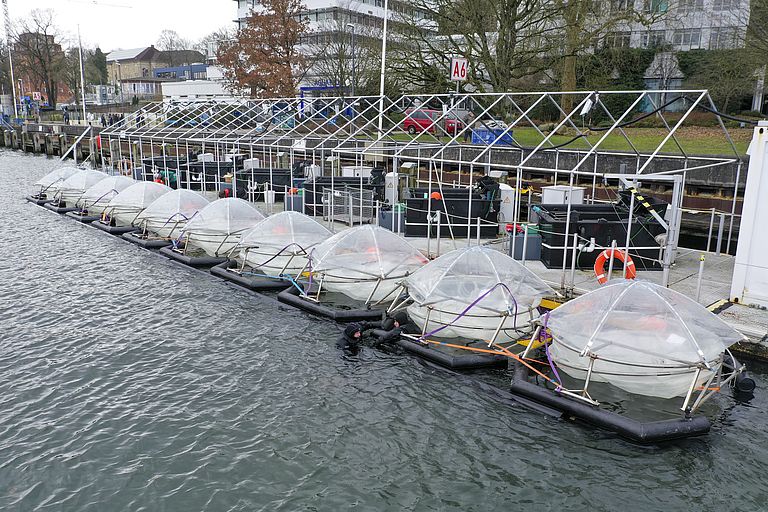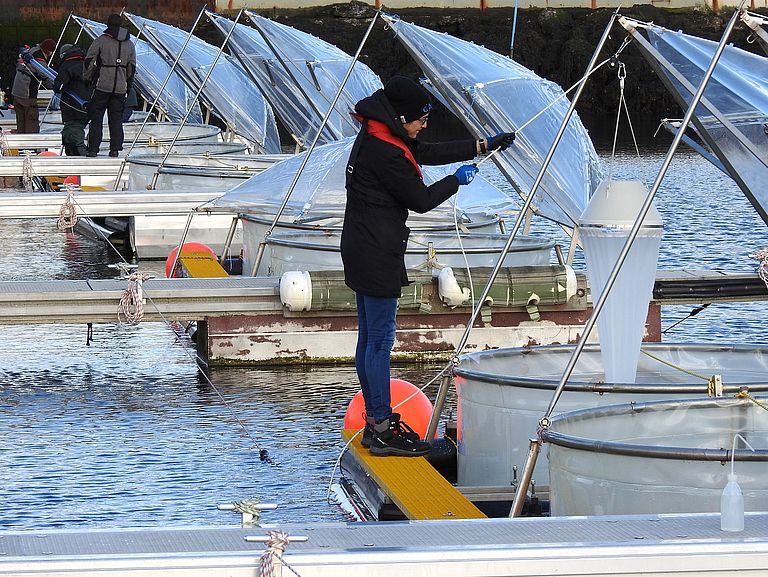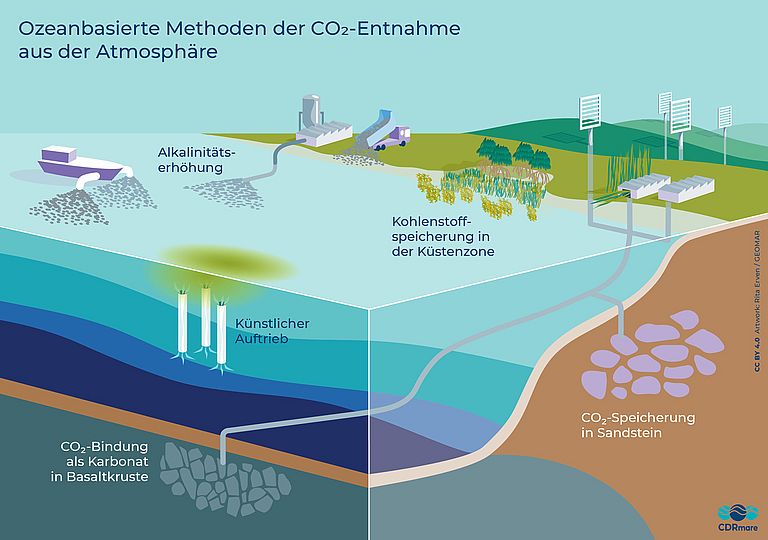Storing carbon dioxide with the help of the ocean – but safely
GEOMAR research provides important information for political decisions
With two key point papers, the German Federal Ministry for Economic Affairs and Climate Protection (Bundesministerium für Wirtschaft und Klimaschutz, BMWK) fleshes out its commitment to climate protection and initiatives to balance carbon dioxide emissions that are currently unavoidable, in particular emissions from cement production and waste combustion. In addition to the key points for the German Carbon Management Strategy and the draft amendment to the Carbon Dioxide Storage Act (Kohlendioxidspeicherungsgesetz), key points for the Long-Term Strategy on Negative Emissions for Dealing with Unavoidable Residual Emissions (Langfriststrategie Negativemissionen zum Umgang mit nicht vermeidbaren Restemissionen, LNe) were also announced. The addressed measures complement the urgent need to drastically reduce greenhouse gas emissions.
GEOMAR Helmholtz Centre for Ocean Research Kiel has more than 15 years of research expertise in the storage of carbon dioxide under the seabed. In addition, GEOMAR scientists are involved in a large number of national and international research projects on marine carbon dioxide removal. For example, the research mission “Marine carbon sinks in decarboniation pathways” (CDRmare) of the German Marine Research Alliance (DAM) is coordinated at GEOMAR. As part of CDRmare, six research consortia investigate various approaches to carbon dioxide removal from the atmosphere and its storage in the ocean in close dialogue with stakeholders.
Capture and storage of carbon dioxide in the seabed
Carbon capture and storage (CCS) was developed to capture greenhouse gas emissions at their source and store them underground. According to scientific work carried out in recent years, CCS technology has been sufficiently researched and can be used. In the deep subsurface of the North Sea, it has already been practised for decades under Norwegian waters. Under the German North Sea, there are rock formations in which large quantities of carbon dioxide could be stored, too. Monitoring and precautionary measures as well as strategies for dealing with possible conflicts caused by other forms of use of the North Sea are necessary in order to minimise risks and avoid hazards.
“The announcement of the key points is an important first step. In the coming months, the German government's Carbon Management Strategy will be published, which will clearly define the sectors for which we need and want to utilise CCS. At the same time, a bill on CO2 storage and transport will be introduced to the Bundestag. As soon as the law comes into force, companies can take action and put their CCS plans into practice,” explains Professor Dr. Klaus Wallmann. The geoscientist from Kiel leads the research network “Submarine Carbon Dioxide Storage in Geological Formations of the German North Sea” (GEOSTOR) of the research mission CDRmare and is a member of the Carbon Management Strategy Expert Council.
However, there is still a long way to go, according to Professor Wallmann: “Suitable sites for CO2 storage under the North Sea must be found and investigated in detail, the infrastructure for CO2 transport must be planned and built and the separation plants at cement and lime or waste combustion plants must be constructed. In addition, public funding is needed to financially support the first CCS projects. It will therefore probably be another ten years or so before things really get underway and CO2 is injected on an industrial scale under the seabed of the German North Sea.”
Ocean-based negative emissions
As agreed in the coalition agreement, the Long-Term Strategy on Negative Emissions for Dealing with Unavoidable Residual Emissions (Langfriststrategie Negativemissionen zum Umgang mit nicht vermeidbaren Restemissionen, LNe) will address approaches that help to achieve net greenhouse gas neutrality by 2045. The methods considered in the recently published key points paper include the conservation and restoration of seagrass meadows and algae ecosystems as well as accelerated weathering – also known as ocean alkalinity enhancement. While natural CO2 sinks can be directly strengthened through immediate measures, for other approaches, the framework conditions for research and risk assessments must first be created.
To respond to the growing interest and increasing activities in the field of ocean-based carbon dioxide removal, the international scientific community has developed guidelines for transparent and sustainable research with substantial contributions from GEOMAR. In a three-part experiment led by GEOMAR which is part of the international project Ocean Alk-Align, scientists from various marine science disciplines investigate this year how marine ecosystems react to alkalinity enhancement from accelerated weathering. Comparable experiments have already been carried out as part of the research mission CDRmare and the Ocean-based Negative Emission Technologies (OceanNETs) project. In addition, experiments on the restoration of seagrass meadows are continuously being conducted in the Kiel Fjord.
“As many start-ups are driving the commercialisation of ocean-based carbon dioxide removal, we are challenged to put research and potential subsequent applications on a responsible basis. In addition to our own research, we have also just published a ‘Best Practices Guide to Ocean Alkalinity Enhancement Research’ in order to ensure the transparency of all research – including by start-ups – and to accelerate the generation of knowledge. However, our efforts have to continue to focus on drastically reducing our emissions,” explains Professor Dr Andreas Oschlies. The head of the research unit Biogeochemical Modelling is co-speaker of the research mission “Marine Carbon Storage in Decarbonisation Pathways” (CDRmare) of the German Marine Research Alliance (DAM). “Together, the approaches considered in the key point papers and strategies can offset a maximum of ten per cent of our current emissions – we need to avoid 90 per cent, and we need a much more ambitious approach.”
“GEOMAR researchers contribute significantly to political and social decision-making in the field of ocean-based climate protection with their findings from national and international projects. The range of our research includes near-natural approaches to CO2 uptake in the ocean such as the renaturation of seagrass meadows, processes related to ocean chemistry such as alkalinity enhancement and the storage of carbon dioxide in the seabed and geological formations,” explains Professor Dr Katja Matthes, Director of GEOMAR. "In dialogues with politicians and other stakeholders, we contribute our expertise to the development of sustainable solutions for pressing social problems. The key points that have now been published outline the way forward in the fight against climate change, and we are very happy to remain involved in the next steps."

In isolated experimental tanks at the Kiel Fjord, researchers led by GEOMAR investigate if the addition of rock powder is able to help the ocean absorb carbon dioxide from the atmosphere and mitigate climate change. Photo: Sarah Kaehlert, GEOMAR

In an experiment at the isalnd of Helgoland in April 2023, researchers investigated the risks and side effects of ocean alkalinisation as part of the RETAKE project of the CDRmare research mission. Photo Ulf Riebesell, GEOMAR

Ocean-based methods of CO2 removal from the atmosphere. Graphic: Rita Erven, GEOMAR


